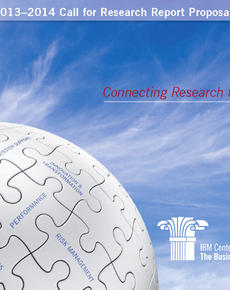
A Call for Research into Key Challenges Facing Government

Last week, The IBM Center for The Business of Government released our most recent “Call for Research Proposals” – a guide to what key challenges faced by government will benefit from Center-sponsored reports in the next several years. The Center solicits proposals that result in reports that have sound research, insightful findings, and actionable recommendations for government leaders and public managers in the following areas of interest – challenges that we consider to be six drivers for change, which I also addressed in testimony on key drivers for government transformation last week before the House Oversight and Government Reform Committee.
- Developing Cost Savings Strategies That Improve Efficiency and Effectiveness. Fiscal austerity will be an enduring challenge for public managers for the foreseeable future, but it can also create an environment and incentives to rethink traditional approaches to mission support and service delivery. Public managers can harness major technological shifts and adapt proven, public sector and commercial best practices to make their agencies both more efficient and productive, and to conduct operations and provide services with greater speed.
- Fostering Innovation and Transformation. Innovation can be viewed as new ideas, or current thinking applied in fundamentally different ways, resulting in significant change in operating models, business processes, or products and services. Transformation refers to broader, and more systemic, changes within an organization. Both innovation and transformation initiatives rely on the use of a set of processes, tools, and culture. Which innovation models lead to true transformation is still unclear, and measures of what constitutes success have yet to be well-defined.
- Aligning Mission Support with Mission Delivery. Agency missions cannot be delivered without mission-support functions such as human resources, acquisition, information technology, and financial management. Over the past 25 years, these mission-support functions have been professionalized and oftentimes centralized, with their leaders often referred to as “chiefs” -- including Chief Financial Officers, Information Officers (CIOs), Technology Officers (CTOs), Acquisition Officers (CAOs), Human Capital Officers (CHCOs), Performance Improvement Officers (PIOs), and others -- and having statutory compliance, policy implementation, service delivery, and strategic advisory roles. Effective mission-delivery leaders can leverage the investment and infrastructure of the various mission-support functions to deliver mission results and improve program efficiencies; effective practices by the various “chiefs” in the public and private sectors can foster improved mission performance.
- Making the Best Use of Performance and Results Management. The federal government has placed sustained attention on improving performance and results for more than two decades. Its strategies have evolved from a focus on agencies and developing a supply of performance information, to a point where today the emphasis is more on selected goals and the effective use of data to inform real-time decision-making. New laws, technologies, and techniques make this possible, but the frontier still seems to be finding ways to integrate performance management into the culture of government, within—and, increasingly, across—agencies. Information about performance and results can be truly impactful in driving agencies toward programs and activities with greatest net benefit.
- Managing Risk in a Rapidly Changing World. Managing risk in the public sphere increasingly takes on new dimensions. These extend from national security risks, to economic risks from natural disasters, to budget and program risks, to privacy risk. Understanding the spectrum of different kinds of risks, developing strategies and tools to mitigate them—as well as incorporating them into decisionmaking—and developing strategies for communicating risks to appropriate target populations, will be a growing challenge for public managers in years to come.
- Developing New Models of Public Leadership Within and Across Agencies. Governments today face serious, sometimes seemingly intractable public management issues that go to the core of effective governance and leadership. These issues test the very form, structure, and capacity required to meet problems head-on. As a result, government leaders find it necessary to go beyond established parameters and institutional strictures, working across organizational boundaries in pursuit of multi-layered, networked approaches that are tailored to a specific challenge --often through “shared leadership” models. Since complex challenges confront people with the unknown and unpredictable, they also demand a different style of leadership—one that shapes vision and fosters alignment and commitment through collaborative action.
We are eager to help communicate what researchers know and learn about what works in these areas to busy government leaders and public managers. Implicit in each of these strategies is the potential of technology and best business practices to help leverage government transformation. Understanding this potential will be an undercurrent in the research we will sponsor. We are looking for proposals that will provide insights, best practices, and practical, actionable recommendations that will have lasting impact on how government works.
We look forward to receiving proposals that continue our partnership with leading public management researchers. Our next deadlines are October 1, 2013; April 1, 2014; and October 1,2014.



